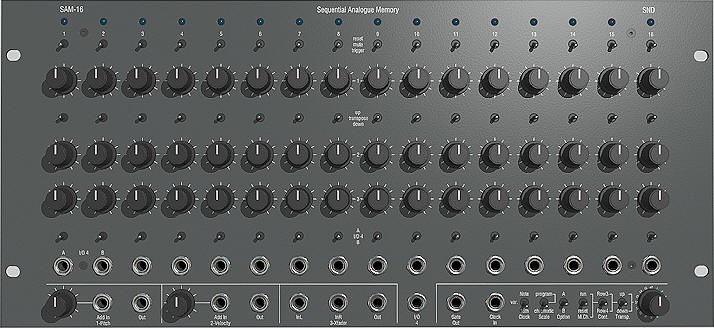SAM-16 Sequential Analogue Memory
| deutsche Version | large view |
high-end MIDI / analogue sequencer
out of production !
| - |
The SAM-16 is a high-end analogue and MIDI-sequencer with special emphasis on tightness and intuitive handling. It has 16 steps, each with the following controls:
|
||||
| - | A fundamental problem of all sequencers using pots and electronic quantisation, is that a control may be (unknowingly) set close to a switching point of the quantizer, such that even a small (and inevitable) drift will cause sudden and unwanted changes in the sequence. The use of rotary encoders for setting the notes eliminates this problem, and - in conjunction with the transpose-switches - it also allows a much more intuitive and predictable control of the sequence. | ||||
| - | The second row of knobs controls MIDI-velocity. In addition to the normal mode there are 6 special modes, in which the SAM-16 simultaniously or alternatingly transmits on 2 MIDI-channels to allow velocity -crossfades and -switching. | ||||
| - | The third row can be used for various functions. It controls either step or gate length, but can also generate another control voltage and/or MIDI-controller (#1-14). In addition it is possible to feed it 1 or 2 audio/CV signals, that appear at the rows output with a different attenuation/mix for each step. | ||||
| - | With the lower row of toggle switches audio and/or CV-signals can be routed from or to 2 busses and 14 individual jacks. This can be used to create ´wave-sequences´ by routing various waveforms of a modular system´s oscillators (or other audio sources) to the filter, or to activate CV-modulations only for certain steps of a sequence. The row can also control the gate length, or generate MIDI-switch-controllers. | ||||
| - | All rows have CV-outputs (0-5V, pitch 1V/octave), rows 1 and 2 also have a CV-input that is added to the values produced by the sequencer. These modulations also influence the MIDI-output data. The input attenuator for pitch modulation doubles as a global tranpose control with a 2-octave range. | ||||
| - |
The build-in MIDI-interface syncronises the SAM-16 to MIDI-clock or MIDI-notes (!) and translates all settings into MIDI-data. Thus it is possible to control classic analogue equipment as well as modern sound generators. Also sequences and their transformations over time can be recorded into a software sequencer for further editing, storage, and recall. A special feature of the MIDI-section is the possibility to ´re-define´ the 12 positions of the pitch encoders, that is to assign any note or chord (up to 7 notes) to each position. The timing control of the SAM-16 also has some advanced options, such as the possibility to wait untill the end of the current measure at any given step. This allows convenient syncronisation even when changing the sequence length. An ´alternating´-mode allows the sequence to be split into 2 halfes, and to switch between them by hand or automatically after 1 - 15 runs. |
||||
| - | Only high-grade controls and components are used in the SAM-16. The internal MIDI-software has been carefully optimized for speed (latency < 0.1 mS) and reliability. | ||||
| - | All CV-inputs/outpus through 1/4"-jacks on the frontpanel, MIDI-In/Thru/Out on the back | ||||
| - | 19", 5 rack units, depth (behind frontpanel): 105mm + plugs, external power supply | ||||
| "... blew us off our chairs", "Creating sequences with this thing is pure fun", "ultra-tight" (Keyboards 3/97) |
|
"... the most elaborate knob-sequencer", "... brings to a point all aspects of analogue sequencer technology", "It is a delight to operate it, its artistic value is enormous", "... is worth its high price" (Keys 10/97) "... not from this world!" (Peter Kruder, Kruder&Dorfmeister) |
